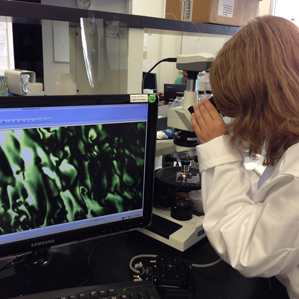Super-Fast Pixels Could Make Smartphones Brighter and Longer-Lasting
Displays account for between 45 and 70 percent of the total energy consumption in portable electronics. A new kind of liquid crystal display (LCD) with pixels that switch much more quickly could give smartphones brighter screens or make them last longer on a charge. The design uses new materials from Light Polymers, a startup based in South San Francisco.

In an LCD, a layer of liquid crystal material in each pixel switches from one state to another to block the passage of specific colors of light.
The new design uses three backlights, one red, one blue, and one green, that illuminate all of the pixels in the display in very rapid succession—too quickly for the eye to perceive. The color of each pixel then depends on perfectly timing when it opens to let light through. If it’s just open for when the blue light is on, it looks blue. Opening it also for some red or green would allow those colors to blend, to create different shades. The design is actually similar to one used for early televisions.
In a conventional LCD, pixels switch much too slowly—in the range of a couple of milliseconds—for the technique to work. Technology presented by Light Polymers at the 2014 Emerging Display Technologies conference in San Jose this week could allow switching in less than 60 microseconds. It involves using a new material that strongly anchors a kind of liquid crystal that switches pixels on and off very quickly.
The new design—known as a sequential display–could help LCDs close the energy efficiency gap with another type of display, the OLED. OLEDs are used in some smartphones and TVs, but are more expensive to produce.
Marc McConnaughey, CEO of Light Polymers, says the company’s materials are being evaluated by flat-panel display manufacturers. They can be swapped in for materials currently used in manufacturing lines, which could make it easier for producers to switch over.
Keep Reading
Most Popular
Large language models can do jaw-dropping things. But nobody knows exactly why.
And that's a problem. Figuring it out is one of the biggest scientific puzzles of our time and a crucial step towards controlling more powerful future models.
The problem with plug-in hybrids? Their drivers.
Plug-in hybrids are often sold as a transition to EVs, but new data from Europe shows we’re still underestimating the emissions they produce.
How scientists traced a mysterious covid case back to six toilets
When wastewater surveillance turns into a hunt for a single infected individual, the ethics get tricky.
Google DeepMind’s new generative model makes Super Mario–like games from scratch
Genie learns how to control games by watching hours and hours of video. It could help train next-gen robots too.
Stay connected
Get the latest updates from
MIT Technology Review
Discover special offers, top stories, upcoming events, and more.